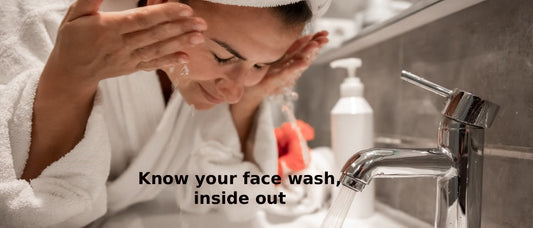
The Intelligent Cleanse: A Guide to What's Really in Your Face Wash
Share
That "Squeaky Clean" Feeling is a Lie
For years, we've been taught that the tight, squeaky-clean feeling after washing our face is the ultimate sign of a job well done. But what if that feeling isn't one of cleanliness, but a cry for help from your skin? The truth is, many of us are caught in a frustrating cycle: we use cleansers that promise clear skin, only to find ourselves battling dryness, irritation, and breakouts. We then buy more products to fix the very issues our cleanser created.
The problem often lies in the bottle itself. Many mass-market brands, in an effort to save costs and create a pleasing sensory experience (like rich foam), rely on cheap, harsh ingredients that do more harm than good. They strip your skin of its natural, protective oils, disrupting its delicate balance and leaving it vulnerable.
To break this cycle, you need to become an educated consumer. Before you read any further, do a simple exercise: go to your bathroom, grab the face wash you currently use, and set it next to you. It's time to become an ingredient detective and find out if your cleanser is your skin's best friend or its secret enemy.
The Ingredient Blacklist: What to Avoid in Your Cleanser
An ingredient list can look like a foreign language, but you only need to recognize a few key culprits. These are the cheap fillers and harsh agents that big brands often use, prioritizing foam and fragrance over your skin's long-term health. Check your bottle for these now.
- Harsh Sulfates (The Strippers): Look for Sodium Lauryl Sulfate (SLS) and Sodium Laureth Sulfate (SLES). These are aggressive detergents that create a satisfying lather but are far too powerful for your face. They strip away not just dirt, but the essential oils that form your skin's protective barrier, leading to dryness, irritation, and even triggering more oil production as your skin tries to compensate.
- Certain Parabens (The Preservatives of Concern): Check for anything ending in "-paraben," like methylparaben or propylparaben. Used since the 1920s as cheap preservatives, there is ongoing scientific debate about their potential to disrupt hormones by mimicking estrogen in the body.6 While regulatory bodies have not banned them, the potential risk has led savvy consumers and premium brands to avoid them altogether.
- Drying Alcohols (The Deceivers): Be wary of Alcohol Denat, SD Alcohol, and Isopropyl Alcohol. These are not the beneficial "fatty" alcohols. These harsh alcohols provide a temporary de-greasing effect that feels good on oily skin, but they cause long-term damage.10 They dehydrate the skin by stripping its moisture, leading to a damaged barrier and, ironically, an increase in oil production and inflammation.
- "Fragrance" (The Hidden Menace): The single word "Fragrance" or "Parfum" on a label is a red flag. This is a legal loophole that allows companies to hide a cocktail of dozens of undisclosed chemicals, including phthalates, which are also linked to hormone disruption. Synthetic fragrances are also one of the leading causes of skin allergies and irritation.
If you see these on your label, it might be time for a change. An intelligent cleanse doesn't strip the skin; it respects it.



